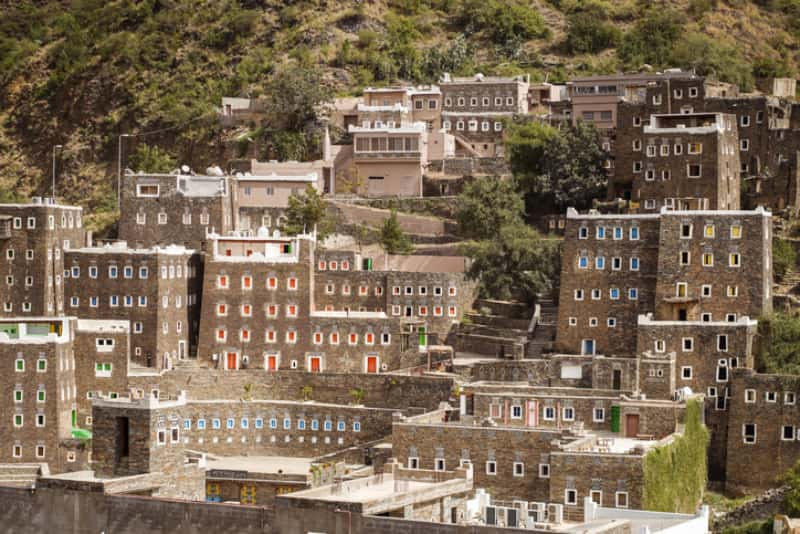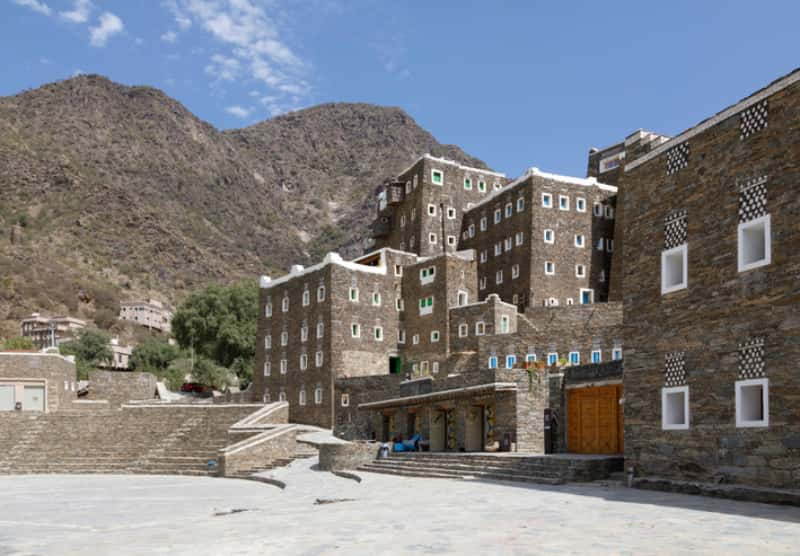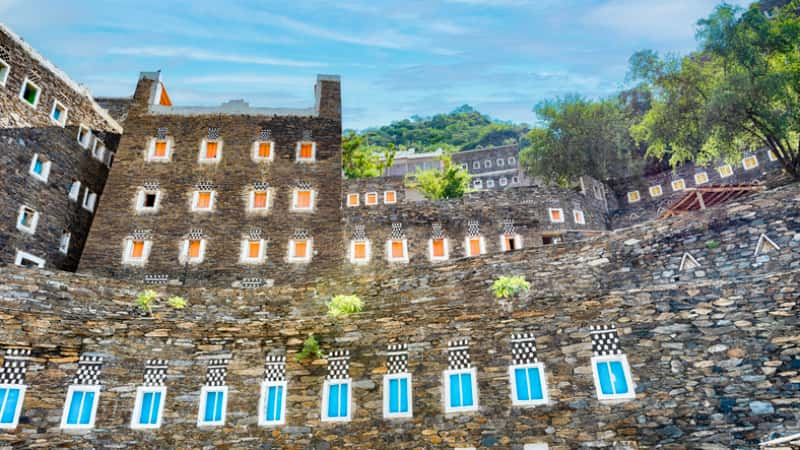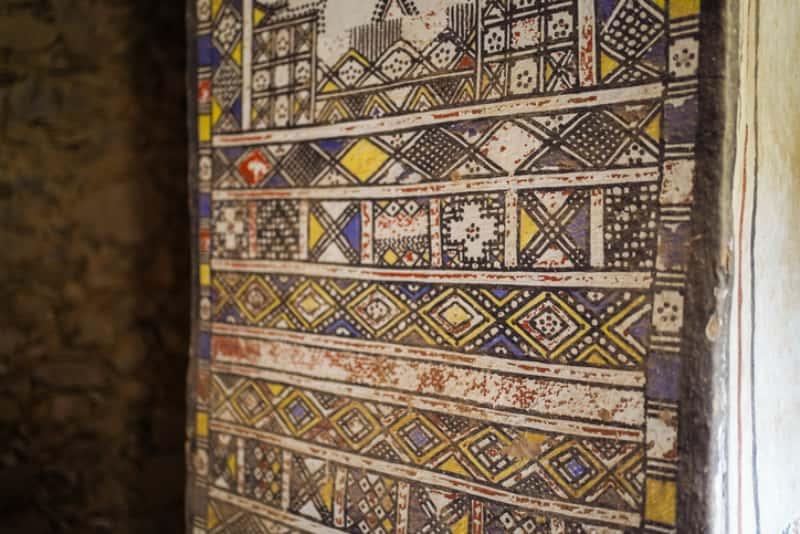Rijal Almaa stands majestically as Saudi Arabia's enchanting "gingerbread village," a 900-year-old settlement showcasing architectural brilliance unparalleled throughout the region. This extraordinary heritage treasure lies nestled within the verdant Asir province, approximately 50 kilometers west of Abha. Visitors marvel at roughly 60 multi-story structures crafted meticulously from stone, clay, and wood, with several buildings soaring impressively to heights of eight floors.
The historical significance of Rijal Almaa extends far beyond its architectural splendor. The village once thrived as a vital trading hub, fostering commercial routes between Yemen and the Levant through the holy cities of Mecca and Medina. This strategic position transformed the settlement into a captivating crossroads of diverse cultural influences. UNESCO acknowledged the exceptional cultural value of Rijal Almaa in 2018, placing it on its tentative World Heritage list. The village's remarkable museum safeguards over 2,000 antiquities and historical documents, thoughtfully arranged across nineteen distinct sections. Among these treasures resides the Al-Qatt Al-Asiri art form, already recognized by UNESCO as an Intangible Cultural Heritage of Humanity.
Visitors to Rijal Almaa encounter the fascinating culture of the "Flower Men," whose distinctive tradition of adorning themselves with floral wreaths traces back more than two millennia. The remarkable preservation of ancient customs alongside architectural marvels has earned this village prestigious recognition from the United Nations World Tourism Organization as one of the world's finest tourism destinations. This guide unveils the myriad wonders awaiting discovery at this cultural jewel, from its structural magnificence to the rich tapestry of traditions that define life in this mountain sanctuary.
The journey between Abha and Rijal Almaa unfolds across the spectacular Asir region, offering travelers varied paths dependent upon their preference for adventure, convenience, and budget considerations. Each route reveals distinct perspectives of the region's breathtaking mountainous terrain.
Rijal Almaa sits approximately 45-51 kilometers from Abha, requiring a journey spanning 1 to 1.5 hours, depending on your selected path. Two distinct routes connect these destinations, each presenting its character and challenges.
Adventurous travelers often select the direct mountain route cutting through the majestic Soudah Mountains. This path weaves dramatically along steep inclines and sharp curves, rewarding drivers with spectacular panoramic vistas at nearly every turn. While local lore occasionally labels this the "unsafe road," experienced drivers find it perfectly manageable, particularly those who appreciate scenic beauty over convenience.
The alternative journey follows Dhila Road, adding approximately one hour to travel time but offering considerably gentler terrain. This route maintains a consistent 100 km/h speed limit throughout its flatter landscape, providing a more relaxed driving experience for those preferring straightforward navigation over mountain switchbacks.
Pleasantly surprising to many visitors, both routes accommodate standard vehicles quite adequately—no specialized 4×4 capabilities prove necessary, even during winter months. Wildlife enthusiasts should remain alert for the region's famous Hamadryas baboons, frequently spotted along roadside areas throughout the journey.
Transportation options beyond private vehicles remain somewhat limited despite conflicting reports. While several authorities insist public transport connections do not exist between these destinations, occasional mentions of bus services appear in traveler accounts.
Taxis represent the most dependable alternative to self-driving, though costs vary dramatically according to different sources. Full-journey private taxis reportedly command between 95-120 USD for one-way travel. Some travelers mention significantly lower fares around 10 USD, though these likely reference shorter segments rather than the complete journey.
Cost-conscious travelers typically find car rentals the most economical option, with daily rates hovering around 30 USD through major agencies operating in Abha. Potential renters should prepare for occasionally time-consuming paperwork processes before embarking on their journey.
Morning departures undoubtedly provide optimal travel conditions between these destinations. Early journeys benefit from reduced traffic volumes, particularly valuable when navigating the more challenging mountain route segments.
Visual clarity presents another compelling argument for morning travel, as the mountain landscapes reveal their full splendor under clear morning light. Local traffic patterns show significant increases during afternoons and evenings when Abha residents commonly visit Rijal Almaa, creating potential congestion.
Travelers planning afternoon departures might consider engaging a local driver familiar with regional routes and driving patterns. This recommendation becomes particularly prudent for journeys extending past sunset, when driving conditions present additional challenges due to visibility limitations and distinctive local driving behaviors.
Morning arrivals offer an additional unexpected benefit—optimal wildlife observation opportunities. The famous Hamadryas baboons display greater activity during early morning hours near the village, typically retreating to less accessible areas as the day progresses.

Rijal Almaa unfolds before visitors as a living museum where centuries-old architecture and cultural treasures await exploration. This historical marvel presents a tapestry of experiences that illuminate the rich heritage of Saudi Arabia's southwestern terrain.
The architectural heart of Rijal Almaa consists of approximately 60 multi-story structures meticulously crafted from natural stone, clay, and wood. These remarkable buildings reach astonishing heights of up to eight floors, bestowing upon the settlement its charming "gingerbread village" moniker—a reference to their distinctive Asiri architectural style. Each building displays tiny, vibrant windows framed by pristine white paint, creating a mesmerizing visual pattern across the village landscape. Al Elwan Fort, the most imposing structure, towers six stories above the village floor. This extraordinary architectural heritage has garnered Rijal Almaa prestigious recognition from UNWTO as an exemplary tourism village while securing its position on UNESCO's tentative World Heritage list.
The Rijal Almaa Museum, established in 1985 through the dedication of residents committed to preserving their cultural legacy, occupies the historic Al Elwan Fort. Within its walls rest over 2,000 antiquities and documents thoughtfully arranged across nineteen thematic sections. The collection showcases traditional jewelry, kitchen implements, utilitarian vessels, ornate coffee pots (dallahs), tools, and household artifacts that narrate daily life through the centuries. The museum's interior walls bear the UNESCO-recognized Al-Qatt Al-Asiri artistic tradition, a decorative form historically created by female artisans. Visitors may explore the museum between 9:00 am and 9:00 pm daily (with closures during prayer times) for an entrance fee of 20 SAR (approximately $5.30).
A cultural journey through Rijal Almaa demands sampling Haneeth, the region's celebrated culinary masterpiece that claimed the 2024 Culinary Arts Region title. This slow-cooked lamb dish, served atop fragrant rice, emerges from a distinctive preparation method involving a specialized sand pit known locally as "mahnaz". Culinary artisans layer the meat with aromatic markh plants before allowing it to cook slowly for 2-3 hours, yielding extraordinarily tender meat infused with complex flavors. Traditional consumption of Haneeth follows communal customs, with family members gathering around a shared plate, though modern accommodations include individual serving utensils upon request.
The geographical positioning of Rijal Almaa within the Asir Mountains provides spectacular vistas across the surrounding terrain. Numerous observation points offer perfect settings for photography enthusiasts, particularly during the golden hours of sunrise and sunset when the skies transform into canvases of vivid color. These panoramic viewpoints reveal lush valleys, undulating hills, and commanding mountain silhouettes, creating natural sanctuaries for contemplation or artistic photography.
The Asir region hosts populations of Hamadryas baboons, fascinating primates native to the Arabian Peninsula. These remarkable creatures, once venerated as sacred beings in ancient Egypt, frequently appear near Rijal Almaa. Early morning hours provide optimal opportunities for baboon sightings, as these primates typically congregate near the museum at dawn before retreating to their natural habitats as the day advances. Wildlife enthusiasts should maintain respectful distances and refrain from offering food to these wild animals.

Beyond the architectural marvels of Rijal Almaa exists a vibrant cultural tapestry bringing the heritage village to life. This mountain settlement preserves distinctive traditions offering visitors an authentic glimpse into centuries-old customs actively practiced today.
The Qahtani tribe, widely known as the "Flower Men," distinguish themselves through their remarkable tradition of adorning colorful floral garlands as headdresses. These intricate wreaths, crafted primarily from marigolds, thyme, and basil, serve dual purposes – both practical and symbolic. Historical accounts reveal these floral crowns originally protected farmers from harsh sunlight during field labor, eventually evolving into a fundamental element of tribal identity. These aromatic arrangements transcend mere decoration; local belief holds they promote health benefits, alleviate headaches, and naturally repel insects.
Male tribe members enhance their distinctive floral headdresses with equally striking attire – calf-length skirts adorned with vibrant horizontal stripes. Many men further embellish their appearance by dyeing both hair and beards a rich red hue using natural henna. Each man traditionally secures a long knife within his waistband, completing this ancestral ensemble that has endured through generations.
The interior walls throughout Rijal Almaa display the exceptional Al-Qatt Al-Asiri, a 300-year-old artistic tradition originating within the Asir province. This remarkable cultural practice, performed exclusively by women, involves adorning interior walls with elaborate geometric patterns rendered in bold, striking colors. UNESCO formally acknowledged this cultural treasure in 2017, officially inscribing it on the prestigious Intangible Cultural Heritage of Humanity list.
These skilled female artists extract natural pigments from local rock formations, producing a vibrant palette dominated by primary colors – yellow, red, blue, and black. The pristine white gypsum base coating, harvested from surrounding mountains, provides the perfect canvas for these intricate designs that tell stories of community, heritage, and identity.
The annual Flowerman Festival celebrates the region's cultural riches across three spectacular weeks, typically unfolding during August and September. This cultural celebration showcases traditional musical performances, captivating dance exhibitions, dazzling light displays, and bustling heritage marketplaces. Recent festival iterations organized under the theme "Nine Centuries of Glory" highlighted three central aspects: "Flower Men and Determination," "Women of Almaa," and "Rijal's Fort".
The village additionally hosts the Saudi Coffee Festival, where over 30 local farmers proudly present their carefully cultivated products. Coffee cultivation constitutes a vital income source for numerous families throughout the region, with some trees boasting extraordinary lifespans exceeding two centuries.

Seamless exploration of Rijal Almaa demands attention to several practical considerations that significantly enhance the cultural immersion experience. Thoughtful preparation allows visitors to navigate this historical treasure while honoring the traditions that have sustained this community for centuries.
Modest attire proves essential when wandering through Rijal Almaa heritage village. Male and female visitors alike should ensure their shoulders and knees remain covered. Female travelers find comfort in flowing long skirts, dresses, or trousers paired with long-sleeved blouses, taking care to select non-transparent fabrics. Gentlemen typically opt for long-sleeved shirts with appropriate trousers. Notably, while local women frequently don abayas and niqabs, such garments remain optional for tourists.
Cultural awareness extends beyond clothing choices. Saudi customs dictate using exclusively the right hand when exchanging objects or consuming food, as the left hand traditionally serves hygiene purposes. Visitors should likewise maintain subdued voices in public spaces, particularly during sacred prayer times and near religious buildings.
The Rijal Almaa Museum welcomes curious minds daily between 9:00 am and 9:00 pm, though doors close temporarily during designated prayer intervals. Most guests discover that 1.5-3 hours provides sufficient time to absorb the wealth of exhibits properly.
Admission costs vary according to different sources. Several reports cite 20 SAR (approximately $5.30), while others mention 40 Riyals (roughly $10). This single entry fee grants comprehensive access to both the museum collections and the surrounding heritage village.
Respectful photography practices demand seeking explicit permission before capturing images of residents or private dwellings within Rijal Almaa. Saudi culture places tremendous value on personal privacy, particularly concerning women, necessitating thoughtful consideration when documenting your journey.
The heritage village boasts exceptional shopping opportunities for discerning collectors. Connoisseurs of authentic Saudi craftsmanship consider this location among the kingdom's premier destinations for genuine mementos. A substantial gift emporium awaits near the village exit, supplemented by smaller specialty shops scattered throughout the historical district offering traditional handicrafts and local delicacies.
Visitors seeking refreshment discover the museum's adjoining restaurant, complete with a scenic terrace overlooking both the ancient architectural marvels and the Grand Mosque—providing an ideal vantage point for contemplative reflection.

Rijal Almaa represents a crown jewel among Saudi Arabia's cultural treasures. This centuries-old settlement transcends mere architectural magnificence, though its distinctive multi-story stone structures certainly define the celebrated "gingerbread" style that draws visitors from across the globe. Wandering through the village pathways reveals a living museum where the famed "Flower Men" maintain age-old traditions, their vibrant floral wreaths and characteristic attire telling stories that stretch back thousands of years. The walls themselves speak of artistic heritage through the UNESCO-recognized Al-Qatt Al-Asiri decorative art form, meticulously preserved through generations of local women artisans.
Travelers planning their expedition from Abha would benefit greatly from early morning departures, when road conditions prove most favorable and opportunities abound for spotting native wildlife along the route. The Rijal Almaa Museum awaits discovery with its remarkable collection of over 2,000 antiquities thoughtfully arranged across nineteen thematic sections—an experience well worth the modest entrance fee. Surrounding mountain landscapes provide breathtaking panoramic vistas, particularly magical during the golden hours of sunset when photographers capture truly spectacular images.
Respectful engagement with local customs through appropriate attire and mindful behavior enhances every visitor's experience of this cultural sanctuary. The culinary journey proves equally rewarding, particularly when sampling traditional specialties like the award-winning Haneeth dish amid the authentic village atmosphere. UNESCO's recognition of Rijal Almaa on its tentative World Heritage list, coupled with the United Nations World Tourism Organization's designation among elite tourism villages, merely confirms what becomes immediately apparent to all who visit—here stands a magnificent portal into Saudi Arabia's cultural soul, preserved with remarkable integrity across nearly a millennium.
Q1. What is the significance of Rijal Almaa?
Rijal Almaa is a 900-year-old heritage village in Saudi Arabia's Asir province, known for its unique "gingerbread" architectural style. It features around 60 multi-story buildings made of stone, clay, and wood, and is recognized as one of the best tourism villages by UNWTO.
Q2. How can I get to Rijal Almaa from Abha?
You can reach Rijal Almaa from Abha by driving (about 45-51 km) or taking a taxi. There are two main routes: a direct mountain road with scenic views, or a longer, flatter road via Dhila. The journey typically takes 1-1.5 hours by car.
Q3. What are the main attractions in Rijal Almaa?
Key attractions include the heritage village architecture, the Rijal Almaa Museum housing over 2,000 antiquities, panoramic mountain views, and the chance to spot Hamadryas baboons. Visitors can also experience local culture through traditional dishes and the unique "Flower Men" tradition.
Q4. What is the Al-Qatt Al-Asiri art form?
Al-Qatt Al-Asiri is a 300-year-old art form from the Asir province, recognized by UNESCO as Intangible Cultural Heritage. It involves women decorating interior walls with intricate geometric patterns using vibrant colors derived from natural pigments.
Q5. What should I keep in mind when visiting Rijal Almaa?
Dress modestly, covering shoulders and knees. The Rijal Almaa Museum is open from 9:00 am to 9:00 pm daily, closing during prayer times. Entry fees range from 20-40 SAR. Always ask permission before photographing people, and respect local customs and privacy.

Find Related Tours


© Copyright 2024 Go Saudi Arabia Trips. All Rights Reserved.